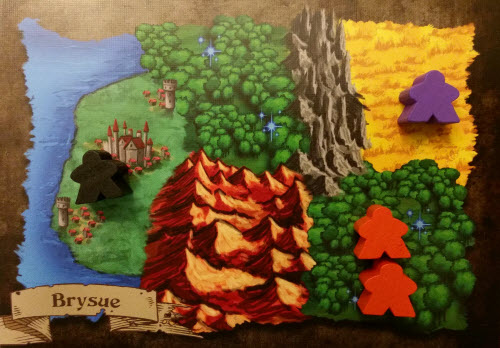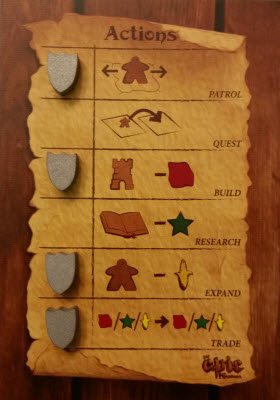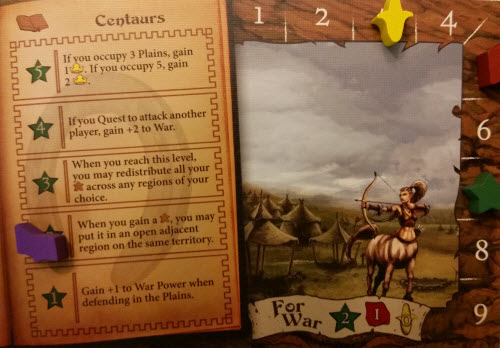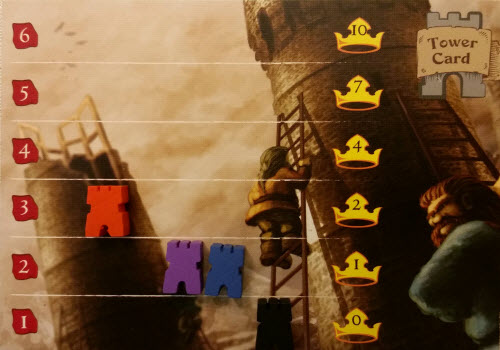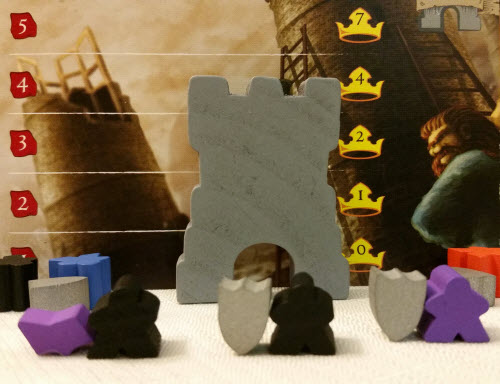King Daron was huddled over a flurry of parchment blanketing the chamber’s massive table. Studying a map of the region with him were his military generals. The combined battlefield experience of the men in the “War Room” – as the keep’s staff has nicknamed the coopted banquet hall – totaled in upwards of eighty years experience. Hardened veterans, and all of them looked quite worried.
Their concentration only broke when a breathless young man burst into room.
“Sire! The enemy is attacking our border! We won’t hold for long.”
“Young man,” Daron replied flatly, “we are well aware of the lizardfolk incursion in the north. Look around. What do you think this is? A tea party?”
“I beg your pardon my liege,” the man said, not missing a beat, “but I was not despatched from the north. I relay to you that our dwarven neighbors to the south are now also on the offensive . . .”
The Premise
This tiny world isn’t big enough for everyone, and that means something needs to give. Players must expand their kingdom through any means necessary. This means everyone will be competing in this increasingly-cramped territory for control of the land, its resources, and the advancements of their respective civilizations.
The Rules
Tiny Epic Kingdoms is billed as a 30 minute 4X game, and it backs up this claim starting with its simple setup. The game principally consists of a series of double-sided Territory Cards, a pair of War Dice, and a variety of player tokens. At the beginning of the game, each player receives colored meeple set, a random Territory Card, and selects one of 13 Faction cards, each of which provides unique abilities. Territory Cards are broken up into regions, and each player starts with two meeples on a region of their card. Players also receive six of the game’s three resources (Food, Ore, and Mana), distributed as they wish. (For example, a player could start with two Food, two Ore, and two Mana.)
The starting player is not explicitly stated in this game. However, we suggest going with the person who has last pillaged something, or barring that, determine it randomly.
Tiny Epic Kingdoms is played over a series of turns. On a player’s turn, they select one of six actions:
- Patrol: Move a meeple to an adjacent region.
- Quest: Move a meeple from a border region of one Territory Card to a border region of another.
- Build: Spend Ore to advance the player one level on the Tower Card.
- Research: Spend Mana to advance the player’s Magic Research one level on their Faction card, thereby gaining access to new special abilities.
- Expand: Spending Food to add a new meeple to any region they currently have a single meeple.
- Trade: Exchange any number of one resource for the same number of another.
Once an action is chosen, it is marked by a Shield token on a central Action card. A player may not take an action with a Shield on it, though once all five Shields are placed they are cleared to start gain. While the active player takes that action (or passes), all other players choose to either also take that action, or collect resources instead. When collecting, players gain resources according to the number and types of regions their units are in.
Should two meeples belonging to different players occupy the same space, a War occurs. Both players may spend Ore and / or Mana towards a War total, secretly tracked using the War Dice. When both dice are revealed, the player with the lower War total loses their meeple. Alternatively, players may offer Peace. If both players select Peace, that region enters an alliance instead of fighting.
Turns continue until one of three conditions are met:
- A player plays their 7th meeple.
- A player reaches the 6th level of their Tower.
- A player reaches the 5th level of their faction’s Magic tree.
Once reached, players finish out that round of actions. Then, players count up VP gained from the number of meeples in play, their Magic and Tower levels, and any City regions they control.
The player with the most VP is the winner, having shown that they are the true Tiny Epic Warlord, and only they have what it takes to propel their kingdom into greatness.
Everyone else may want to consider another line of work.
It’s A 3.5X Thing
Two of the pillars of a 4X game – eXploit and eXterminate – revolve around leveraging the resources of your area to your advantage and directly attacking other players to stop, cripple, or eliminate them, and although antagonistic, they are a central premise of the genre. While it’s entirely possible to play entire sessions without going for another player’s throat, permanently taking out the competition is one option in the 4X toolbox. The problem that arises is that because normal 4X games tend to be lengthy, if someone is hamstrung too early, they can stagnate. Even if rebuilding is an option, for a time you are forced to switch from Competing to Win simply to Competing to Survive.
Tiny Epic Kingdoms avoids this hosing problem in a few ways. Firstly, it’s far shorter. You only have to worrying about resources and progression over a scant 30 minutes, reducing anxiety should something happen to you early on.
Secondly, it scales down the right materials proportionally. It’s not that there isn’t room in 30 minute games for massive armies to fight over large swaths of territory, but Tiny Epic Kingdoms is about doing more with less. By only focusing on three resources, three win conditions, and just a handful of actions, the game effectively distills the essence of a 4X into a manageable scope without being overly complicated. Ironically, at first Tiny Epic Kingdoms may not actually seem like it has much depth at all, but that notion is dispelled with just a few turns.
Finally, the game deftly balances versatility with accessibility. That is, Tiny Epic Kingdoms wants you to be able to go for a Magic victory in one game while shooting for a population victory in another. By letting you do things like select your starting faction and resources, it ensures that each game will be a different experience. At the same time, the game wonderfully accommodates new players with ease – always a hallmark of good small box games.
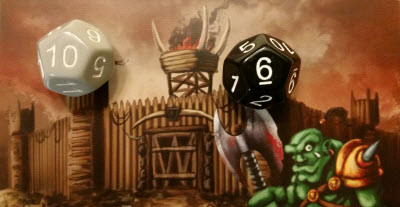
War is simple: whoever spends more wins.
Besides its easily learned rules, Tiny Epic Kingdoms ensures that you don’t have to be a veteran to enjoy it. This is exemplified through its simple process for resolving Wars, as well as including a handful of (almost convoluted) rules to guarantee that players can never actually die.
If ever relegated to a single meeple unit, not only are you impervious to being attacked, but your worker conveniently generates twice as many resources as a means of getting you back on your feet. In that sense, this game is more akin to a “3.5X “game, as player elimination is not possible here.
All told, these aspects make Tiny Epic Kingdoms playable in a variety of settings and groups with relative ease. So much so, in fact, that even though it’s not the heaviest on player interaction, Socializers can still enjoy this strategic endeavor.
Cutting Things Down To Size
There is a general correlation between the size of a game and the degree of its thematic resonance. Smaller games have an imperative to be cohesive and fun without being overwhelming, whereas larger games have more room to world build and use flavor to give meaning to their more complex setups.
Tiny Epic Kingdoms partially escapes that mold. While you never feel like the theme is tacked on, it is still pretty sparse. For example, the Landscape Cards may have kingdom names, but they are never referenced, nor do the landscapes have many defining characteristics from one another. The artwork to these cards is also very basic, offering something reminiscent of early tabletop or computer game maps. These cards are functional and clear to understand, but they also aren’t much to look at.
However, this fact is offset with the use of faction cards and custom meeples. Each of the factions’ abilities allow them to operate differently, providing you with a great deal of variety. More notably, though, is that each faction’s abilities are thematically linked. The Dwarves have an affinity for Ore, the Merfolk avoid the normal penalties for water, and the Hobbit-esque Halflings get bonuses for avoiding conflict. These thematic-mechanical mergers are very well done, providing a distinctly different experience with each faction.
At the same time, the game offers custom tokens for every trackable attribute. From the Tower and Shields to the different resource trackers, every token is tailored for its specific purpose. Not only is this commendable for a game this size, but they also reinforce the game’s simple flavor. It’s unfortunate that the Ore and Magic trackers are not as well defined as the rest, though, for while it’s a minor issue, it is noticeable.
That being said, although Tiny Epic Kingdoms competently generates some light flavor for its theme, it still won’t be enough for Immersionists to grab on to.
Meeting With The War Council
It is impressive how much Tiny Epic Kingdoms keeps the spirit of a 4X game alive when shrunk into a miniaturized version, and for that feat alone it should be praised. Yet that does affect who is willing to rush headlong into the breach.
Strikers will certainly enjoy this half hour melee for dominance. This is a game that is low on luck and set goals, which should be music in this group’s ear…even if that music is the pounding of war drums. Similarly, Tacticians should find enough to keep them interested at least in the short term. With only has a handful of paths to victory and not a lot of profundity in the process of getting there, it doesn’t initially appear as though they’d enjoy this compact game, but Tiny Epic Kingdoms administers a healthier dose of strategy than it seems. Nevertheless, their enjoyment will be partially contingent on which faction they use – the more complicated the better.
On the other hand, Daredevils best look for grander locales elsewhere. Even with the variety of factions, there aren’t a lot of avenues in these shrunken realms to express their unconventional nature. Although there is room to take some gambles in Tiny Epic Kingdoms, but this is not a game of high risk & high reward.
Surprisingly, Architects are going to be the ambivalent ones about the game. This group is often conflicted with 4X games as they synchronously appeal to their love of exploration and building assets while also providing players the ability to completely disrupt that progress. Tiny Epic Kingdoms is definitely appealing to them given that it eliminates player elimination, but with the short play time and limits on how much stuff they can have (resources, units in one location, etc.), they’re left conflicted. Architects will likely be willing to play this game, but whether they find it enjoyable will be up to the individual.
The Takeaway
For a micro-sized world, Tiny Epic Kingdoms offers a surprisingly robust experience in a short window of time. With an abundance of individually-tailored factions and layouts that change every playthrough, Tiny Epic Kingdomss provides a good deal of replayability without being overly complex. Indeed, one of the game’s best attributes is being both accessible and substantive. While this game will not replace the deep immersion and nuanced complexities of a full-fledged 4X experience, its smaller footprint casts a wider net. It properly condenses the mindset and strategic calculations of its 4X cousins, offering a light-scale game that is neither daunting nor one requiring prior experience to win. For those seeking a quick, portable, and low pressure contest over who shall rule, Tiny Epic Kingdoms is a good destination choice.
Tiny Epic Kingdoms is a product of Gamelyn Games.
Cardboard Republic Snapshot Scoring (Based on scale of 5):
Artwork: 3.5
Rules Clarity: 4.5
Replay Value: 4
Physical Quality: 3.5
Overall Score: 3.5
Photo Credits: Honey I Shrunk The Kids by Disney Entertainment.

